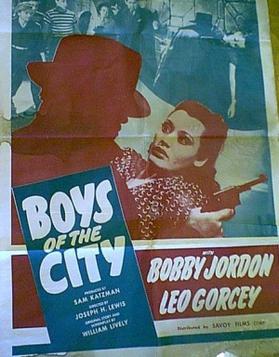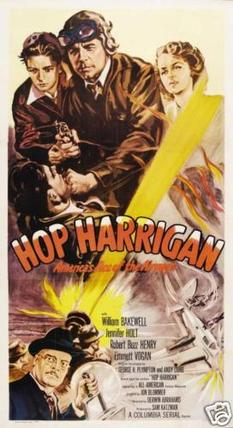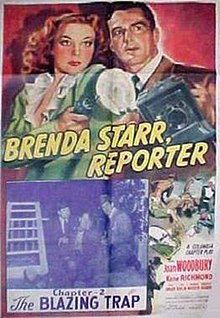
Brenda Starr, Reporter is a comic strip about a glamorous, adventurous reporter. It was created in 1940 by Dale Messick for the Chicago Tribune Syndicate, and continued by others until 2011.

John E. Moran was an American movie actor who, from 1936 to 1946, appeared in over 30 films, primarily in teenage roles.

Sam Katzman was an American film producer and director. Katzman's specialty was producing low-budget genre films, including serials, which had disproportionately high returns for the studios and his financial backers.

The Lost Planet is a 1953 American science fiction serial film 15-chapter serial which has the distinction of being the last interplanetary-themed sound serial ever made. It was directed by Spencer Gordon Bennet with a screenplay by George H. Plympton and Arthur Hoerl. It appears to have been planned as a sequel to the earlier chapterplay Captain Video: Master of the Stratosphere and shares many plot-points, props and sets, as well as some of the same cast. However, the Video Rangers do not appear, and their uniforms are instead worn by "slaves" created electronically by Reckov, the dictator of the Lost Planet with the help of mad scientist Dr. Grood and enslaved "good" scientist Professor Dorn.

The Adventures of Captain Africa is a 1955 adventure serial film directed by Spencer Gordon Bennet and starring John Hart.

Boys of the City is a 1940 black-and-white comedy/thriller film directed by Joseph H. Lewis. It is the second East Side Kids film and the first to star Bobby Jordan, Leo Gorcey, and Ernest Morrison.

The Ape Man is a 1943 American horror film directed by William Beaudine. The film is based on "They Creep in the Dark" by Karl Brown, which was published in The Saturday Evening Post. It stars Bela Lugosi as Dr. James Brewster who is aided by his colleague Dr. Randall. The doctor manages to transform himself into a ape man hybrid and desperately seeks a cure. Brewster believes that only the injection of human spinal fluid will prove effective as a cure. As Randall refuses to help him, Brewster and his captive gorilla seek involuntary donors.
The Bowery Boys are fictional New York City characters, portrayed by a company of New York actors, who were the subject of 48 feature films released by Monogram Pictures and its successor Allied Artists Pictures Corporation from 1946 through 1958.

Wheeler Oakman was an American film actor.

Adventures of Sir Galahad is the 41st serial released in 1949 by Columbia Pictures. Directed by Spencer Gordon Bennet, it stars George Reeves, Nelson Leigh, William Fawcett, Hugh Prosser, and Lois Hall. It was based on Arthurian legend, one of the very few serials of the time with a period setting that was not a western.

Who's Guilty? is a 1945 American film serial. It was the 28th of 57 serials released by Columbia Pictures. Who's Guilty? was a rare attempt at a whodunit mystery film in serial form. The serial's villain was designed to look like The Shadow on the poster. The film co-starred some well-known character actors, such as Charles Middleton, Wheeler Oakman, and Minerva Urecal. Robert Kent played the lead role of Detective Bob Stewart.

Hop Harrigan (1946) is a Columbia film serial, based on the Hop Harrigan comic books by DC Comics. The serial comprised 15 two-reel chapters with Derwin Abrahams as the director, and Sam Katzman, the producer. Columbia Pictures was one of the last Hollywood studios to continue in postwar years with the serial format. By 1947, Universal Pictures discontinued their serials, with only Republic Pictures and Columbia continuing with serials. The last serial was Columbia's Blazing the Overland Trail (1956).

Joan Elmer Woodbury was an American actress beginning in the 1930s and continuing well into the 1960s.

Brenda Starr is a 1989 American adventure film directed by Robert Ellis Miller based on Dale Messick's comic strip Brenda Starr, Reporter. It stars Brooke Shields, Timothy Dalton, and Jeffrey Tambor.
Lee Zahler was an American composer and musical director of films, starting in the 1920s and well into the 1940s.
The East Side Kids were characters in a series of 22 films released by Monogram Pictures from 1940 through 1945. The series was a low-budget imitation of the Dead End Kids, a successful film franchise of the late 1930s.
Edward J. Kay was an American film composer and musical director, who worked on over 340 films from the 1930s into the 1960s, and was nominated on multiple occasions for an Academy Award for Best Original Score, although he never won. On his last film, 1962's The Creation of the Humanoids, he was also a producer.

John Merton was an American film actor. He appeared in more than 250 films between 1927 and 1959, mostly as a villain. He was the brother of filmmakers André de la Varre and William LaVarre, the father of actor Lane Bradford, the grandfather of actress Diane Delano, and the great-uncle of academic Hollis Robbins.
Derwin Abrahams (1903–1974) was an American film director. He directed four serials in the 1940s for Columbia Pictures, including Hop Harrigan, Chick Carter, Detective, Tex Granger, and Son of the Guardsman, followed by The Great Adventures of Captain Kidd in 1953. He also directed around two dozen western features, as well as episodes of the TV series The Adventures of Kit Carson, Hopalong Cassidy and The Cisco Kid.

A serial film,film serial, movie serial, or chapter play, is a motion picture form popular during the first half of the 20th century, consisting of a series of short subjects exhibited in consecutive order at one theater, generally advancing weekly, until the series is completed. Usually, each serial involves a single set of characters, protagonistic and antagonistic, involved in a single story, which has been edited into chapters after the fashion of serial fiction and the episodes cannot be shown out of order or as a single or a random collection of short subjects.














